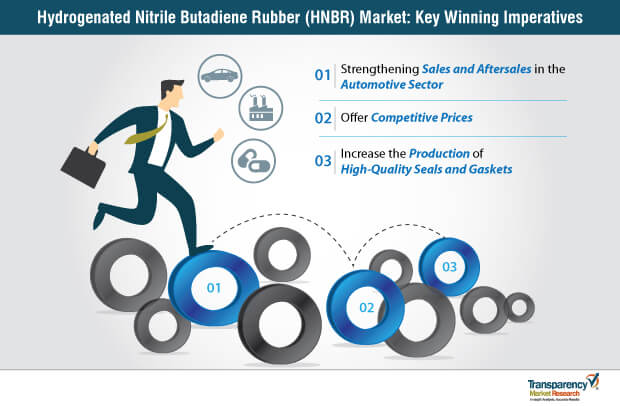
Hydrogenated Nitrile Butadiene Rubber (HNBR) Market: Broadened Scope of Application to Underpin Growth
Shifts in the preference from nitrile butadiene rubber (NBR) to hydrogenated nitrile butadiene rubber (HNBR) has led to HNBR becoming one of the fast growing raw materials in the production of rubber articles. The perpetual rise in consumer preference for high-quality rubber calls for a change in the production process of rubber. Due to its physical strength and splendid retention properties, hydrogenated nitrile butadiene rubber finds center stage in numerous automotive, construction, oil and gas, and machinery applications. The automotive industry alone accounted for 47% share in the hydrogenated nitrile butadiene rubber market in 2018.
Request Brochure:
https://www.transparencymarketresearch.com/sample/sample.php?flag=B&rep_id=24782
Considering the popularity of hydrogenated nitrile butadiene rubber in numerous industrial applications, and its contribution to the growth of the synthetic rubber industry, manufacturers are vying towards increasing their production capacities for HNBR. Sensing the high demand for hydrogenated nitrile butadiene rubber in the end-use sector and the volatility in the prices of natural rubber leading to a shift towards synthetic rubber, TMR has conducted extensive research on the hydrogenated nitrile butadiene rubber market. In its new study, TMR lays bare the key trends in the hydrogenated nitrile butadiene rubber market, and explains how the change in opportunities has impacted the key strategies of stakeholders in the HNBR market space.

More Trending Reports by TMR:
Evolutionary Landscape of the HNBR Market
The synthetic rubber market is a key example of how volatility promotes growth. The synthetic rubber market came into the picture when the economic slowdown and low prices started hampering the natural rubber industry. It has now become an important commodity catering to the rising demand due to industrialization. Among the numerous synthetic rubbers in the market, hydrogenated nitrile butadiene rubber finds extensive application across a number of industries. The global hydrogenated nitrile butadiene rubber is projected to be valued at ~ US $ 63 Mn by the end of 2027, states TMR.
HNBR got its very own eminence because of the rising global competition in the automotive industry. New trends in engine designs called for the need to incorporate high-performance material in developing timing belts. To address this need, automotive manufacturers started moving away from polychloroprene to replace it with HNBR as the key raw material for timing belts.
Not just automotive manufacturers, but giants in the oil and gas industry eyed hydrogenated nitrile butadiene rubber for numerous oilfield applications such as sealing, gaskets, down-hole packers, and others. Although the risk of substitution continues to be a longstanding challenge for partakers in the hydrogenated nitrile butadiene rubber market, it presents an opportunity for the development of products with enhanced properties.
REQUEST FOR COVID19 IMPACT ANALYSIS:
https://www.transparencymarketresearch.com/sample/sample.php?flag=covid19&rep_id=24782
Key Trends Transitioning the Market
Governments Providing Assistance for Rubber Production
The governments of numerous leading rubber producing countries such as Thailand, India, Indonesia, and Sri Lanka are providing economic assistance to rubber manufacturers in the form of subsidies, tax breaks, as custom duty waivers. For instance, the Indian government has helped the rubber growers and manufacturers through various efforts such as trade fairs and buyer-seller meets.
Similarly, in Thailand, the government supported the rubber industry by establishing a free trade agreement with rubber importing countries such as New Zealand and Australia. These efforts stem from rising rubber exports from these countries to different parts of the world, and the building of pressure to enhance the production of rubber. In a bid to reduce the transportation costs for raw materials and increase revenue outcomes, leading tire manufacturers in North America and Europe are outsourcing their operations to rubber producing countries such as China and India.





